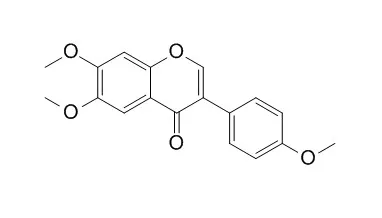| Kinase Assay: |
| Phytomedicine, 2014, 21(4):570-577. | | Flavonoids promoting HaCaT migration: II. Molecular mechanism of 4',6,7-trimethoxyisoflavone via NOX2 activation.[Reference: WebLink] | Flavonoids are major active ingredients in plants and are considered components of food that provide medical or health benefits. They have diversified structures and have effects on human health, including wound healing induction. More than a hundred flavonoids were screened for HaCaT keratinocytes cellular migration measurements and the relationships between their structural properties and the effects promoting cellular migration were examined.
METHODS AND RESULTS:
Here, among flavonoids used in the previous structure-activity relationship calculations, 4',6,7-Trimethoxyisoflavone (TMF) was one of the compounds showing the best activity, so that its molecular mechanism of the wound healing effect on HaCaT keratinocytes was investigated in more detail. Our data revealed that TMF increased the wound healing rate, but not the proliferation rate, in a dose-dependent manner. Treatment of keratinocytes with TMF influenced signaling pathways, affecting the phosphorylation of AKT and ERK in a time-dependent manner. TMF also induced the cell-cell adhesion protein E-cadherin, which is essential for promoting collective cell migration. Furthermore, the TMF treatment group also showed higher ROS and NOX2 transcriptional and protein levels. Correlating with matrix metalloproteinase induction by TMF, levels of extracellular matrix proteins such as collagens I and III were significantly lower in the treatment group. To confirm that the effects of TMF occur through the NOX2 pathway, we co-treated cells with TMF plus an NADPH inhibitor (DPI) or a ROS scavenger (NAC). Western blotting revealed that DPI and NAC attenuated the effect of TMF, suggesting that TMF induces ROS through the NOX2 pathway and regulates keratinocyte migration.
CONCLUSIONS:
In summary, TMF promotes wound healing through NOX2 induction, which leads to collective migration and MMP activation. |
|






 Cell. 2018 Jan 11;172(1-2):249-261.e12. doi: 10.1016/j.cell.2017.12.019.IF=36.216(2019)
Cell. 2018 Jan 11;172(1-2):249-261.e12. doi: 10.1016/j.cell.2017.12.019.IF=36.216(2019) Cell Metab. 2020 Mar 3;31(3):534-548.e5. doi: 10.1016/j.cmet.2020.01.002.IF=22.415(2019)
Cell Metab. 2020 Mar 3;31(3):534-548.e5. doi: 10.1016/j.cmet.2020.01.002.IF=22.415(2019) Mol Cell. 2017 Nov 16;68(4):673-685.e6. doi: 10.1016/j.molcel.2017.10.022.IF=14.548(2019)
Mol Cell. 2017 Nov 16;68(4):673-685.e6. doi: 10.1016/j.molcel.2017.10.022.IF=14.548(2019)